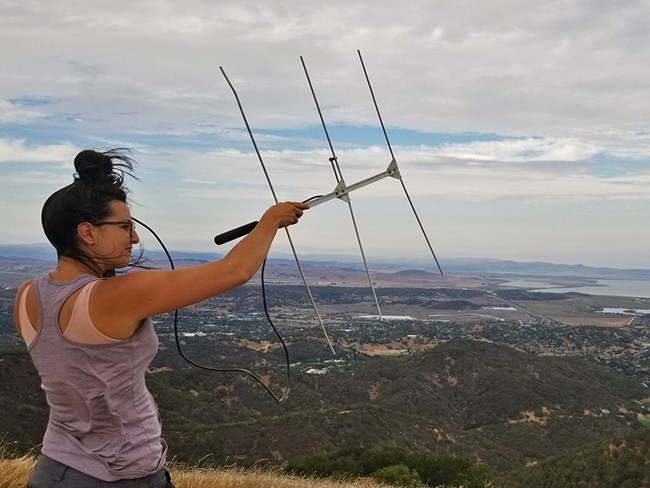Last updated: October 29, 2021
Article
Marin Bat Project Resumes Radio Telemetry After Covid-19 Hiatus; Continues Acoustic Monitoring

NPS / Katie Smith
October 2021 - Since the Marin Bat Monitoring project began in 2017, USGS and One Tam partner scientists have combined acoustic monitoring, mist netting, and radio telemetry monitoring techniques to better understand San Francisco Bay Area bat populations. Acoustic monitoring refers to recording bat calls with acoustic detectors and assessing which species are present and active in an area, while mist netting and radio telemetry involves fitting bats with tiny transmitters and tracking them to their roosts. This approach offers a richer, more comprehensive picture not only of which bats are present on the landscape, but how they are using habitat.
But beginning in March 2020, concerns over the unknown risk of transferring COVID-19 from humans to bats halted mist netting and radio telemetry monitoring. Fortunately, the Marin Bat Monitoring Team was finally able to safely resume the bat-handling portion of their research in summer 2021.
This is good news. Understanding how bats are using habitat is critical for strategically protecting bat populations as fire mitigation projects (fuels reduction, tree thinning, prescribed burning) ramp up. The parks have historically taken similar precautions for nesting landbirds and raptors, as they are protected by the Migratory Bird Treaty Act. However, bats and some of other wildlife don't have these same legal protections, even though they are a vital part of healthy ecosystems. The Marin Bat Project team is currently working to address this issue.

NPS / Katie Smith
Summer Radio Telemetry Leads Scientists to Five Roost Sites
One Tam partner scientists collaborated to capture 12 bats via mist netting at Deer Island Preserve over the course of four nights in August. They attached temporary radio transmitters to eight of those bats, representing three different species: yuma myotis, California myotis, and little brown bat, before releasing them back into the wild. Notably, little brown bats (Myotis lucifugus) are one of the species most impacted by white-nose syndrome. They are currently listed as endangered in several US states and throughout Canada, and are undergoing a species status assessment under the Endangered Species Act. Fortunately, researchers have not observed any signs of white nose syndrome in local bat populations.
Using data from the attached transmitters, the team was able to locate five roost sites used by the tracked bats. The roost structures included trees, private residences, and a state park-owned bat box!
Acoustic Monitoring Towards Filling Data Gaps
In addition, the team continued with acoustic monitoring throughout 37 park locations across Marin County this June and July. Analysis of acoustic monitoring data helps researchers better understand the presence of various species on the landscape. This monitoring data will be shared in a state-wide database under NABat, a multi-agency monitoring effort focused on providing a better picture of bat populations regionally and across North America.
For more information
- Contact Assistant Biological Monitor Katie Smith
- Learn more about bat conservation in the San Francisco Bay Area.
- Bats are very important ecologically, but are often maligned and misunderstood. Learn more about the myths and misconceptions surrounding bats with this engaging and informative video created for the San Francisco Public Library by Parks Conservancy wildlife technician, Katie Smith.
- One Tam Bat Monitoring webpage
- USGS Bat Research in California webpage
- Pacific Coast Science and Learning Center Bats webpage
